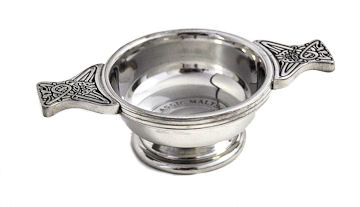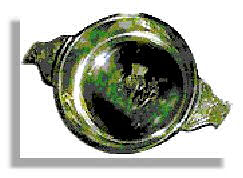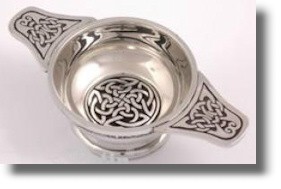Background
 The Quaich (pronounced "quake", from the Gaelic word "cuach") has a rich heritage in Scotland - indeed, they are a uniquely Scottish invention, having no apparent connection to any other European drinking vessel.
This traditional Scottish drinking vessel was used to offer a guest a cup of welcome and also as a farewell drink, usually a dram of whisky. Travellers were known to carry a quaich with them.
The Quaich (pronounced "quake", from the Gaelic word "cuach") has a rich heritage in Scotland - indeed, they are a uniquely Scottish invention, having no apparent connection to any other European drinking vessel.
This traditional Scottish drinking vessel was used to offer a guest a cup of welcome and also as a farewell drink, usually a dram of whisky. Travellers were known to carry a quaich with them.
Origins
They were used for whisky and brandy but there was also larger quaichs which were used for ale. (The largest surviving examples having capacity of about 1.5 pints).
It is believed that one of their ancestors was the scallop shell, in which drams of whisky were taken in the Highlands and Islands.
Like the shells, quaichs were always wide and shallow. The distinctive shape has been fixed now for possibly more than four hundred years.
How Were They Made?
Traditionally made of wood, it is a shallow circular-drinking vessel for whisky, with a pair of small lug handles projecting horizontally from opposite sides of the rim. The lugs, though functional, are of a unique carved style giving the quaich much of its special character.
The making of these cups was an intricate art by which the quaich was either turned from the solid or built up with tiny staves. The best quaichs, considered to be masterpieces, were built up with light and dark wood staves and bound round with withies or metal bands. The dozen or so staves of alternating woods such as plane-tree and laburnum were coopered together and also 'feathered' into each other; this was a technique in which small slivers of wood were split away from the sides of the staves and slotted into equivalent parings cut in the opposite direction.
The centre of the bowl was usually decorated with a silver coin or an engraved disc or 'print', with coat-of-arms, initials, motto or familiar phrase such as 'drink up'. The disc served the function of masking and sealing the centre of the bowl where the points of the staves met.
The Quaich Moves Up-Market
 Quaichs began to be made in metal, whether pewter or silver and gold, in the late seventeenth century. Silver quaichs for example are first mentioned in the 1660s. When silversmiths began to make quaichs, they carefully and deliberately engraved radiating lines on the bowl in imitation of the staves of wooden quaichs and horizontal rings to represent the withy bindings. They also copied the lug handles in every respect.
Quaichs began to be made in metal, whether pewter or silver and gold, in the late seventeenth century. Silver quaichs for example are first mentioned in the 1660s. When silversmiths began to make quaichs, they carefully and deliberately engraved radiating lines on the bowl in imitation of the staves of wooden quaichs and horizontal rings to represent the withy bindings. They also copied the lug handles in every respect.
Quaichmaking was a highly regarded profession in 17th century Scotland. Quaichmakers probably made all sorts of wooden eating and drinking vessels, but took the name of their profession from their best work, much as workers in silver and gold called themselves goldsmiths.
As with all things, imitation is the sincerest form of flattery. Quaichs became so highly regarded that the upper-crust just had to have them made from precious metals. This posed something of a problem, since wooden quaichs are solid and quite thick at the bottom - it would be a bit difficult for a fine Scottish lady to sip delicately from a solid silver ale quaich the weight of a small boulder. The answer was to make the quaich of sheet-silver, so that the sides were of constant thickness. This allowed metal quaichs to imitate the outer form of wooden quaichs, but made the inner cavity much deeper and more bowl-like.
The earliest quaichs were single-timber, meaning that they were made of a single piece of wood turned on a lathe. The lugs were sometimes covered with silver, providing a place for initials. It was a passion in 17th century Scotland to place your initials everywhere: on your silverware, your furniture, the lintel, ceiling, and panelling of your house, and of course on your quaich.
The Quaich in 1745 travelled from Edinburgh to Derby with the Scottish Army in Bonnie Prince Charlie's canteen. Its bottom was made of glass so that the drinker could keep watch on his companions.
A more romantic Quaich had a double glass bottom in which was kept a lock of hair, so that the owner could drink to his lady love; and in 1589 King James VI of Scotland gave Anne of Norway a Quaich or "Loving Cup" as a wedding gift.
Modern Quaichs
In more recent times, the Quaich has been used as a favour at many Scottish weddings, being presented to all at the top table. A symbol of the shared love and partnership between their hosts. Also at christenings (in Kilmuir in Scotland, there is a wooden quaich which was formerly used as a baptismal font, thus the quaich has become a traditional baptismal gift), or even births, to drink the health of a bairn and to share the love and celebration of that new life.
Buying a Quaich

Tin Gifts, based in Cornwall, which has been associated with tin mining since before Roman times, have a range of quaichs made from pewter (a malleable metal alloy, traditionally 85–99% tin), which can be used for drinking and also given to mark christenings and weddings. Adding an engraving makes the quaich stand out and provide a stunning gift. The company has made every effort to make a striking, highly polished quaich decorated with Celtic knot work in various designs to create a most attractive product. Tin Gifts can deliver their quaichs from an agent in North America, thus reducing postage costs for deliveries in that part of the world.
The Quaich in Scottish Culture
The Quaich has a rather unique history and is surrounded by myth and mystique. In ancient time, during the Celtic period, it is believed that the Druids filled the quaich with blood from the heart of sacrificed humans.
It has a special place in the heart of all who know something of its history and is a prized possession of many people who have an association with Scotland. And will always be remembered in its traditional use as a visitor's welcome or farewell cup by proud clan chiefs, worthy merchants or humble crofters, and in this, the quaich has kept its simple but beautiful shape and friendly purpose.
This feature is courtesy of ©Huntingtower©.



